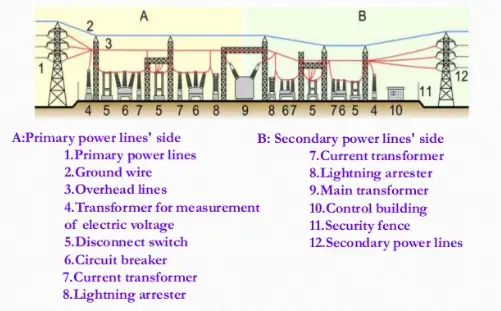The main components of a substation are
- Busbars
- Surge or Lightning Arresters
- Isolators or disconnecting switches
- Earth Switch
- Circuit Breaker
- Power Transformer
- Wave Trap
- Current Transformer
- Potential Transformer

1. Busbars
It is a strip or bar of copper, brass or aluminium that conducts electricity within a switchboard of a substation. Its main purpose is to conduct electricity, not to function as a structural member. Busbars receive power from incoming circuits and deliver power to outgoing circuits.
2. Surge or Lightning Arresters
It discharges the over voltage surges to earth and protects the equipment insulation from switching surges and lightning surges. It generally connected between phase conductor and ground.
3. Isolators or disconnecting switches
Isolators are provided for isolation from line parts for the purpose of maintenance. Isolators are operated under no load. It does not have any rating for current breaking or current making.
4. Earth Switch
It is used to drain out stray charges left over a transmission line. Since a transmission line also behaves as a capacitor, so to avoid shock earthing is provided.
5. Circuit Breaker
It is always used in conjunction with relays to sense the fault and relay give a signal to the trip coil of a circuit breaker to remove the contact.
6. Power Transformer
They are used to step-up or step-down AC voltages and to transfer electrical power from one voltage level to another.
7. Wave Trap
Wave trap is a device which prevents the high-frequency carrier signals to enter the substation side. It is also known as line trap. It is connected in series with the transmission line. You read about it in detail here.
8. Current Transformer
They are used for stepping down the current for measurement, protection, and control.
9. Potential Transformer
They are used for stepping down the voltage for measurement, protection, and control.
